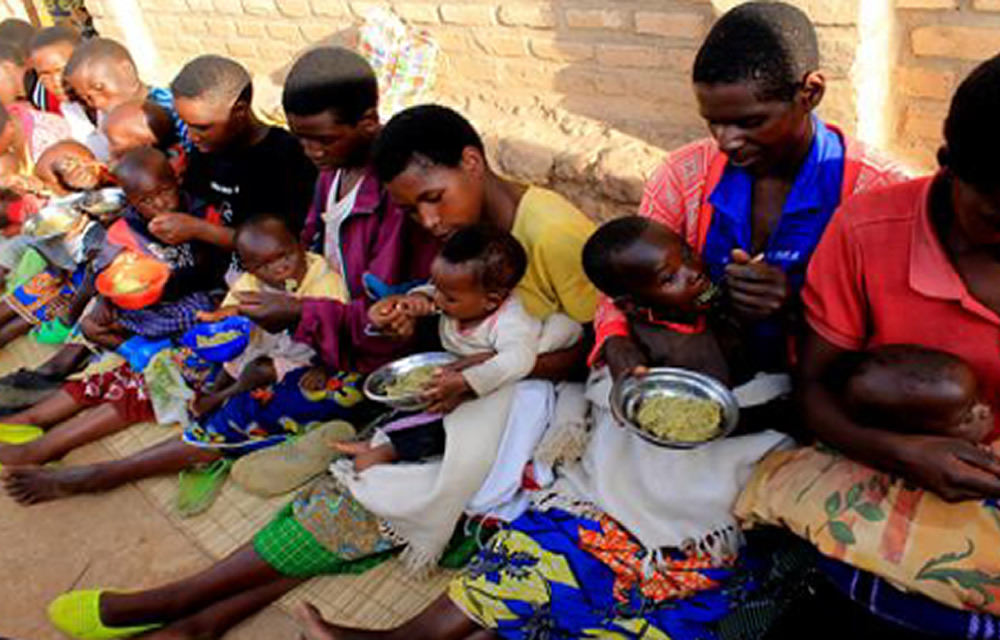
Nyamagabe Community Starts Campaign Against Malnutrition
Nyamagabe is one of the districts still most affected by poverty due to acidic soils that have affected crop production which in turn is the main cause of malnutrition.
As a way of eradicating malnutrition, many households in Nyamagabe benefited from the One-Cow-per-Poor-Family program, provided by the government, while World Vision also provided cows to households in the area.
As a way of giving back to their community, residents in Nyamagabe set up the cooperative Our Milk in 2012 with 24 members, and started a campaign to fight malnutrition among children. The cooperative, located in Tale sector, also aimed at creating a source of income for its members.
Letitia Nyiranzabandora, 26, said they were given cows, all of which gave birth, but they did not have market for their milk and there was no way of eradicating malnutrition. But after the cooperative set up a milk center, with the support of World Vision, it offered a market for more than 100 suppliers. The milk, after being tested and treated at the center, is carried to markets in little red trucks
The Milk Collection Center was linked to the markets in Kigeme refugee camp, Gasarenda, Rusizi, Nyamagabe town and Bukavu that has enabled the development of milk industry in Nyamabage.
However, some of the mils is set apart for malnourished children.
“We locate malnourished children and those at risk in the area, and they are brought to the center every day to drink milk as a way of fighting malnutrition in the area; if they improve and we send them off and bring others,” Nyiranzabandora said.
‘Near death’
Among other children that survived malnutrition is Moses Muhire, 10 years old.
“When Moses arrived one year ago, he was near death, he was critical,” Nyiranzabandora said. “His eyes were pale, his hair yellow and soft, his cheeks were swollen.”
milk (1)
Moses Muhire with one of the members of the Our Milk cooperative. (courtesy photo)
Moses weighed less than 15 kilogram. “I had never seen a child like that,” she said, adding that Moses was very weak, had no appetite and could not play so he did not interact with other children.
“Today he is alive and healthy; he runs and has a passion for life. The first time I saw him, I didn’t have hope that he would have a future, but I have so much hope now,” Nyiranzabandora said.
Moses said that, because of the milk program, he has gained energy and weight to 20 kg in one year.
“I was at risk of hunger. I suffered from stomach pain day and night due to starvation, and lost a lot of weight. Sometimes, children in my village made fun of me, saying I had AIDS,” Moses said confidently and with a clear loud voice.
Commercial villages
“We were extremely happy to receive cows. We thought selling off surplus milk would greatly improve our income,” said Francis Habitegeka, one of the farmers in the area. “When the cows gave birth, we failed to find market for the milk produced. The remoteness of our village made it impossible to access market for our milk. Life changed when the milk collection center opened its doors.”
However, the milk suppliers are encouraged to put their families first and ensure they have all the milk they need before they sell what remains.
The milk center was created in the context of World Vision Rwanda’s model that builds on community empowerment through investing in Village Savings and Loan Associations (VSLAs) and the Commercial Villages Model.
According George Gitau, the World Vision Rwanda National Director, the empowerment model aims at encouraging and developing the skills of household members for self-sufficiency, with a focus on eliminating the future need for aid.
“We work with the communities until they graduate from subsistence to commercialized market-led agricultural production units; we teach them how to catch a fish, instead of constantly giving them a fish,” he said.



